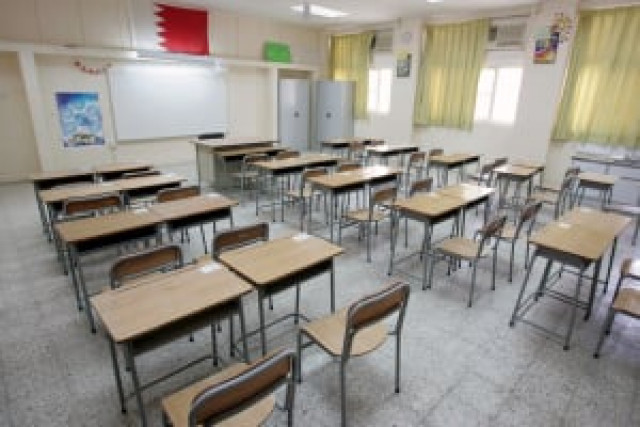Ex-FATA schools struggle with missing facilities, student absenteeism
IMU submits first report on schools of NMDs to the provincial minister

Empty classroom representational image. PHOTO: AFP
This was disclosed in the first Independent Monitoring Unit (IMU) report of the Khyber-Pakhtunkhwa government on schools in the newly-merged tribal districts. Earlier this year, Advisor to Chief Minister on Education Affairs Ziuallah Bangash had directed the government’s IMU — set up in 2014 for regular monitoring of all government schools in the province — to collect data regarding schools in the ex-Fata areas.
Presented before the provincial education minister in a high-level meeting on Tuesday, the report noted that the 550 IMU Data Collection and Monitoring Assistants (DCMAs) visited the 5,788 of 5,889 schools of the newly-merged districts including in Bajaur, Bannu (FR Region), Dera Ismail Khan (FR Region), Khyber, Kohat (FR Region), Kurram, Lakki Marwat (FR Region), Mohmand, North Waziristan, Orakzai, Peshawar (FR Region), South Waziristan and Tank (FR Region).
During their visits, they could not visit some 101 schools, or two per cent of all schools, owing to the adverse security situation.
ECP urged to ensure free, fair elections in ex-FATA
Of these, they could not access 14 schools in Bajaur, 49 in North Waziristan and 38 in Khyber.
In the schools they could visit, the DCMAs said that 27 per cent or some 1,443 schools were closed. These included 1,276 schools which were closed on that particular day owing to absenteeism while 167 schools had been closed for over six months. Around 32% of all closed schools were girls schools while 23% were boys schools.
Most of the ‘permanently non-functional’ schools, around 40, were located in the Mohmand tribal district, followed by 38 in Kurram and 27 in Khyber. South Waziristan had the most number of temporarily closed schools or around 371, followed by 295 in North Waziristan and 187 in Bannu.
Monitors also discovered that as many as 33 schools were either partially or fully occupied. Most of the partially occupied government schools, 12, were located in Mohmand, followed by eight in Bannu and four in North Waziristan. Two schools which were fully occupied were located in Bannu and Kohat respectively.
The report noted that of the 14,877 teachers on the books in the 5,889 schools and seminaries in the ex-Fata areas, some 2,618 teachers of 17.6% were absent. Of those, 1,243 teachers were not authorised to be absent while 719 had sanctioned leaves. A further 596 were deputed elsewhere.
Of those on unauthorised leaves, most were from primary schools – 660, followed by 332 high school teachers and 215 middle school teachers.
K-P Assembly backs internet connectivity in ex-FATA
Highest teacher absenteeism was recorded at 40% in Bannu (406 absent including 303 on unauthorised leaves), and Lakki Marwat (111 absent including 91 unauthorised). It was followed at 33.5% by North Waziristan (528 absentees with 400 unauthorised).
Tank had the fewest absentees at 2.1% with just eight teachers absent, including six unauthorised.
With 508,937 students enrolled in these schools, their overall student attendance was just 62 per cent.
Highest student absenteeism was at 70% in Lakki Marwat (3,557 absent of 5,047 enrolled), followed by 60% in Bannu (12,919 absent in of 21,462 enrolled students), and 59% in Tank (6,386 absent of 10,803 enrolled).
Even FR Peshawar had 35% of its 13,672 students absent. In absolute terms, most students absent from schools were in Khyber were 41,714 students or 45% of its 93,116 enrolled students absent. It was followed by Bajaur with 28,023 students, Mohmand with 25,971 students and 24,097 students in North Waziristan.
On the facilities end, the report showed that 55% of schools in the newly-merged districts did not have any electricity, while 51% of schools lacked drinking water facilities.
Around 30% did not have any toilets and a further 18% lacked boundary walls — crucial given the security situation in the region.
Lakki Marwat consistently appeared as the region which most lacked critical facilities.
Bangash said that they want to bring education levels in the newly-merged districts at part with that in the settled districts. He added that the provincial government has allocated Rs36 billion for education development in the financial year 2019-20.
With the report highlighting the deficiencies of the education system in the newly-merged areas, the provincial will try to sort out all outstanding problems during subsequent education years while the issue of school dropouts in the newly merged districts will also be addressed, the CM’s adviser stated.
Published in The Express Tribune, July 17th, 2019.













COMMENTS
Comments are moderated and generally will be posted if they are on-topic and not abusive.
For more information, please see our Comments FAQ